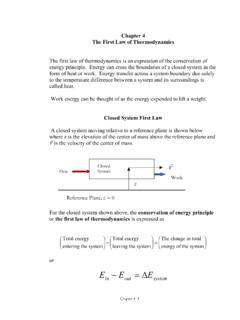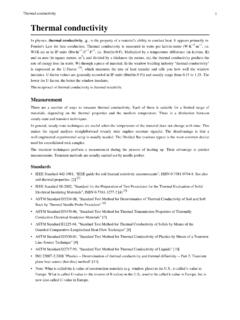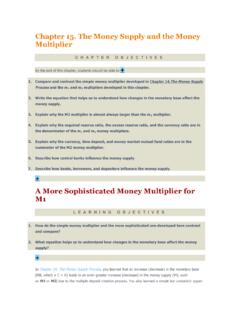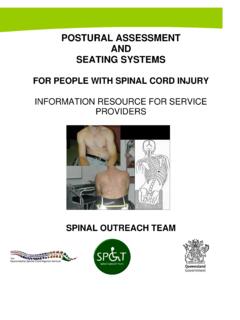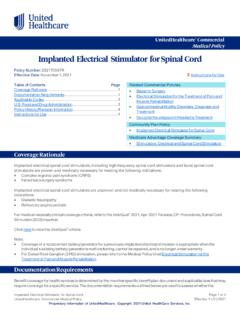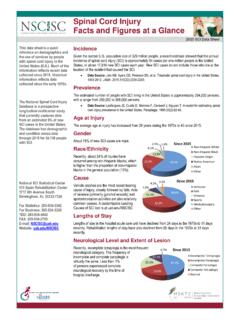Transcription of Human Physiology/The Nervous System
1 Human Physiology/The Nervous System1 Human Physiology/The Nervous System Integumentary System Human Physiology Senses Homeostasis Cells Integumentary Nervous Senses Muscular Blood Cardiovascular Immune Urinary Respiratory Gastrointestinal Nutrition Endocrine Reproduction (male) Reproduction (female) Pregnancy Genetics Development AnswersThe central Nervous System includes the brain and spinal cord. The brain and spinal cord are protected by bonystructures, membranes, and fluid. The brain is held in the cranial cavity of the skull and it consists of the cerebrum,cerebellum, and the brain stem. The nerves involved are cranial nerves and spinal systemOverview of the entire Nervous systemThe Nervous System has three main functions: sensory input,integration of data and motor output. Sensory input is when the bodygathers information or data, by way of neurons, glia and synapses.
2 Thenervous System is composed of excitable nerve cells (neurons) andsynapses that form between the neurons and connect them to centersthroughout the body or to other neurons. These neurons operate onexcitation or inhibition, and although nerve cells can vary in size andlocation, their communication with one another determines theirfunction. These nerves conduct impulses from sensory receptors to thebrain and spinal cord. The data is then processed by way of integrationof data, which occurs only in the brain. After the brain has processedthe information, impulses are then conducted from the brain and spinalcord to muscles and glands, which is called motor output. Glia cells arefound within tissues and are not excitable but help with myelination,ionic regulation and extracellular Nervous System is comprised of two major parts, or subdivisions,the central Nervous System (CNS) and the peripheral Nervous System (PNS).
3 The CNS includes the brain and spinal cord. The brain is thebody's "control center". The CNS has various centers located within itthat carry out the sensory, motor and integration of data. These centers can be subdivided to Lower Centers(including the spinal cord and brain stem) and Higher centers communicating with the brain via effectors. The PNSis a vast network of spinal and cranial nerves that are linked to the brain and the spinal cord. It contains sensoryreceptors which help in processing changes in the internal and external environment. This information is sent to theCNS via afferent sensory nerves. The PNS is then subdivided into the autonomic Nervous System and the somaticnervous System . The autonomic has involuntary control of internal organs, blood vessels, smooth and cardiacmuscles. The somatic has voluntary control of skin, bones, joints, and skeletal muscle.
4 The two systems functiontogether, by way of nerves from the PNS entering and becoming part of the CNS, and vice Physiology/The Nervous System2 General functions of the CNSB rain, brain stem, and spinal :The "Central Nervous System ", comprised of brain, brainstem, andspinal central Nervous System (CNS) represents the largest part of thenervous System , including the brain and the spinal cord. Together, withthe peripheral Nervous System (PNS), it has a fundamental role in thecontrol of CNS is conceived as a System devoted to information processing,where an appropriate motor output is computed as a response to asensory input. Many threads of research suggest that motor activityexists well before the maturation of the sensory systems, and sensesonly influence behavior without dictating it. This has brought theconception of the CNS as an autonomous and function of neuronsStructureNeurons are highly specialized for the processing and transmission ofcellular signals.
5 Given the diversity of functions performed by neurons in different parts of the Nervous System , thereis, as expected, a wide variety in the shape, size, and electrochemical properties of neurons. For instance, the soma ofa neuron can vary in size from 4 to 100 micrometers in soma (cell body) is the central part of the neuron. It contains the nucleus of the cell, and therefore is where mostprotein synthesis occurs. The nucleus ranges from 3 to 18 micrometers in diameter. The dendrites of a neuron arecellular extensions with many branches, and metaphorically this overall shape and structure is referred to as adendritic tree. This is where the majority of input to the neuron occurs. However, information outflow ( fromdendrites to other neurons) can also occur (except in chemical synapse in which backflow of impulse is inhibited bythe fact that axon do not possess chemoreceptors and dendrites cannot secrete neurotransmitter chemical).
6 Thisexplains one way conduction of nerve impulse. The axon is a finer, cable-like projection which can extend tens,hundreds, or even tens of thousands of times the diameter of the soma in length. The axon carries nerve signals awayfrom the soma (and also carry some types of information back to it). Many neurons have only one axon, but thisaxon may - and usually will - undergo extensive branching, enabling communication with many target cells. The partof the axon where it emerges from the soma is called the 'axon hillock'. Besides being an anatomical structure, theaxon hillock is also the part of the neuron that has the greatest density of voltage-dependent sodium channels. Thismakes it the most easily-excited part of the neuron and the spike initiation zone for the axon: in neurological terms ithas the greatest hyperpolarized action potential threshold.
7 While the axon and axon hillock are generally involved ininformation outflow, this region can also receive input from other neurons as well. The axon terminal is a specializedstructure at the end of the axon that is used to release neurotransmitter chemicals and communicate with targetneurons. Although the canonical view of the neuron attributes dedicated functions to its various anatomicalcomponents, dendrites and axons often act in ways contrary to their so-called main and dendrites in the central Nervous System are typically only about a micrometer thick, while some in the peripheral Nervous System are much thicker. The soma is usually about 10 25 micrometers in diameter and often is not much larger than the cell nucleus it contains. The longest axon of a Human motor neuron can be over a meter long, reaching from the base of the spine to the toes.
8 Sensory neurons have axons that run from the toes to the dorsal columns, over meters in adults. Giraffes have single axons several meters in length running along the entireHuman Physiology/The Nervous System3length of their necks. Much of what is known about axonal function comes from studying the squids giant axon, anideal experimental preparation because of its relatively immense size ( 1 millimeters thick, several centimeterslong).FunctionSensory afferent neurons convey information from tissues and organs into the central Nervous System . Efferentneurons transmit signals from the central Nervous System to the effector cells and are sometimes called motorneurons. Interneurons connect neurons within specific regions of the central Nervous System . Afferent and efferentcan also refer generally to neurons which, respectively, bring information to or send information from brain by action on other neuronsExcitatory neurons excite their target postsynaptic neurons or target cells causing it to function.
9 Motor neurons andsomatic neurons are all excitatory neurons. Excitatory neurons in the brain are often glutamatergic. spinal motorneurons, which synapse on muscle cells, use acetylcholine as their neurotransmitter. Inhibitory neurons inhibit theirtarget neurons. Inhibitory neurons are also known as short axon neurons, interneurons or microneurons. The outputof some brain structures (neostriatum, globus pallidus, cerebellum) are inhibitory. The primary inhibitoryneurotransmitters are GABA and glycine. Modulatory neurons evoke more complex effects termedneuromodulation. These neurons use such neurotransmitters as dopamine, acetylcholine, serotonin and others. Eachsynapses can receive both excitatory and inhibitory signals and the outcome is determined by the adding up and inhibitory processNerve SynapseThe release of a excitatory neurotransmitter(ACHe) at the synapses will cause an inflowof positively charged sodium ions (Na+)making a localized depolarization of themembrane.
10 The current then flows to theresting (polarized) segment of the synapse causes an inflow of Cl-(chlorine) or outflow of K+ (potassium)making the synaptic membranehyperpolarized. This increase preventsdepolarization, causing a decrease in thepossibility of an axon discharge. If they areboth equal to their charges, then theoperation will cancel itself out. There aretwo types of summation: spatial and temporal. Spatial summation requires several excitatory synapses (firing severaltimes) to add up,thus causing an axon discharge. It also occurs within inhibitory synapses, where just the oppositewill occur. In temporal summation, it causes an increase of the frequency at the same synapses until it is largeenough to cause a discharge. Spatial and temporal summation can occur at the same time as neurons of the brain release inhibitory neurotransmitters far more than excitatory neurotransmitters, which helpsexplain why we are not aware of all memories and all sensory stimuli simultaneously.
